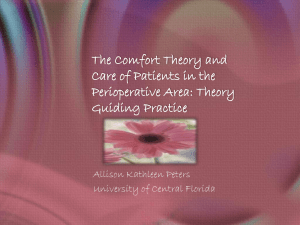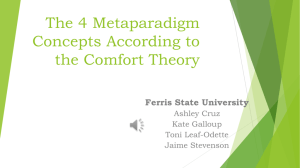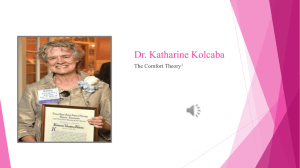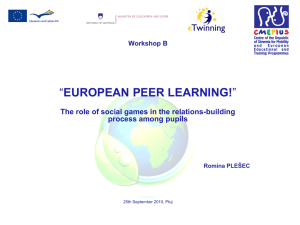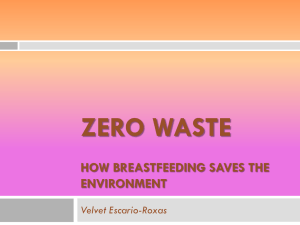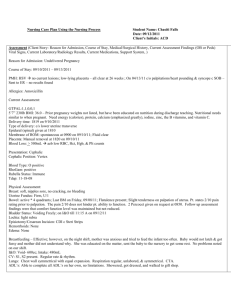Maternal Infant Bonding
advertisement
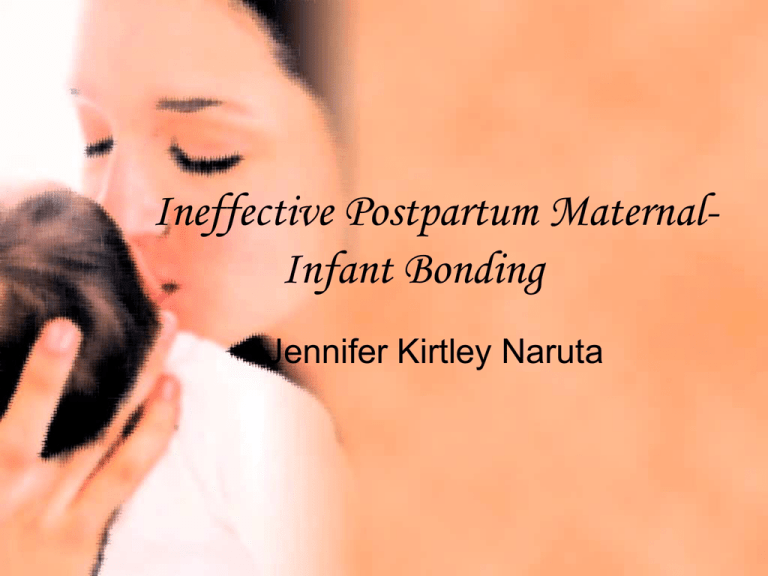
Ineffective Postpartum MaternalInfant Bonding Jennifer Kirtley Naruta Background • Infants are dependent upon family members, especially mother, for care and nurturing. • Newborns send cues to bid for attention – Signs of discomfort, bids for interaction or other needs like hunger and discomfort (Amankwaa & Pickler, 2007). • Postpartum bonding occurs via skin-toskin contact, breastfeeding, simple touch and voice from the mother. Background Positive Outcomes of Effective Bonding Infant • Decreased crying, increased warmth, opportunity to breastfeed, thermoregulation, pain management, easier transition to extra-uterine life (Bystrova, Widstrom, et al., 2003; Dabrowski, 2007). Mother • Increased oxytocin release (UnvasMoberg, 1998), opportunity to breastfeed and learn nonverbal cues from infant. Background Ineffective Bonding Repercussions for the infant (As cited in Leitch, 1999; Ip, Chung, et al., 2007) • Developmental delays • Social, cognitive and linguistic limitations • Child abuse and neglect • Failure to thrive (FTT) • Health problems – Otitis media – Respiratory tract infections – Type 2 diabetes and obesity – SIDS Background The United States of America has the lowest initiation rates of breastfeeding at 27 to 69.5% (Callen & Pinelli, 2004). Problem Statement Ineffective maternal-infant bonding can lead to poor cognitive and developmental outcomes for the infant as well as a decrease in the immediate and future relationship of the mother and infant. Significance Nurses are typically the primary caregivers during the postpartum period and are “in perfect position to initiate interventions to enhance the activities of engagement that are so important to maternal role transition” (Sanders & Buckner, 2006). Significance Maternal-Infant bonding in the hospital • Infant should be placed on mother’s chest immediately following delivery, regardless of route of delivery. • “Apgar scores, initial assessment and placement of newborn identification bands, may be performed immediately after birth while the newborn is in skinto-skin contact with its mother” (Dabrowski, 2007). Significance • Cost to healthcare for children that are abused, neglected or have FTT. • Breastfeeding seminars/classes offered to mothers – Allows for continued bonding between mother and infant – Creates new jobs for nurses – Allows for professional stability of nursing. Specific Aims • Apply Kolcaba’s Theory of Comfort • Help assist mothers and newborns transition effectively from intrauterine to extra-uterine life. Theory • Kolcaba’s Theory of Comfort – Developed in 1994 – “Can be “adapted to any patient or age group” (Kolcaba, 2004). – Concepts (McEwin & Wills, 2007) • Comfort, comfort measures, comfort care, comfort needs, institutional integrity, health-seeking behaviors and intervening variables. – Patients need comfort in stressful times, especially times that are healthcare related (McEwin & Wills, 2007). Application of Theory • Therapeutic use of self by nurses – Encouraging effective bonding • Increases comfort between mother and infant. Summary & Conclusions • Maternal-infant bonding is important – Negative outcomes can result, for mother and baby, if not done effectively. • Nurses should be proactive for effective bonding between mother and baby – Encourage breastfeeding and skin-to-skin contact – Educate mothers and assist where needed • Theory of Comfort assists with an easier transition for both mother and baby References Amankwaa, L., & Pickler, R. (2007). Measuring maternal responsiveness. Association of Black Nursing Faculty Journal, 18(1), 4-15. Bystrova, K., Widstrom, A.M., Matthiesen, A.S., Ransjo-Arvidson, A.B., Welles-Nystrom, B., & Wassberg, C., et al. (2003). Skin-to-skin contact may reduce negative consequences of “the stress of being born”: A study on temperature in newborn infants subjected to different ward routines in St. Petersburg. Acta Paediatrica, 92(3), 320-326. Callen, J., & Pinelli, J. (2004). Incidence and duration of breastfeeding for term infants in Canada, Unitied States, Europe, and Austrailia: A literature review. Birth, 31(4), 285-292. Ip, S., Chung, M., Raman, G., et al. (2007). Breastfeeding and maternal and infant health outcomes in developed countries. Rockville, MD: US Department of Health and Human Services. Retrieved April 10, 2009, from http://www.ahrq.gov/downloads/pub/evidence/pdf/brfout/brfout.pdf Kolcaba, K. (2004) Comfort. In S.J. Peterson & T.S. Bredow (Eds.), Middle range theories: Application to nursing research (p 255-273). Philadelphia: Lippincott Williams & Wilkins. Leitch, D.B. (1999). Mother-infant interaction: Achieving synchrony. Nursing Research, 48(1), 5558. McEwen, M., & Wills, E.M. (2007). Theoretical Basis for Nursing (2nd ed.). Philadelphia: Lippincott Williams & Wilkins. Sanders, L.W., & Buckner, E.B. (2006). The newborn behavioral observations system as a nursing intervention to enhance engagement in first-time mothers: Feasibility and desirability. Pediatric Nursing, 32(5), 455-459. Unvas-Moberg, K. (1998). Oxytocin may mediate the benefits of positive social interactions and emotions. Psychoneuroendocrinology, 23(8), 819-838.


